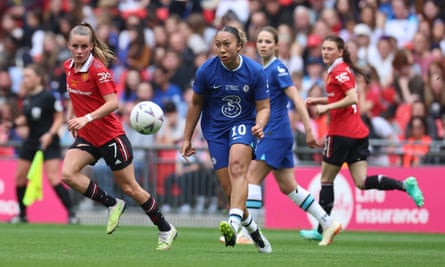Chloe Kelly’s ebullient celebrations as the Lionesses were crowned European champions last summer marked a distinct uptick in the mood around women’s football in England. At the 2023 Fifa Women’s World Cup in Australia, they are high on confidence, knowing they go into the tournament as one of the favourites.
And the Lionesses seized on their new high profile and swell of public affection, writing a striking open letter last year in which they declared: “Currently only 63% of girls can play football in PE lessons. The reality is we are inspiring young girls to play football, only for many to end up going to school and not being able to play.”
They asked the government to ensure that girls had access to at least two hours a week of physical education, and to ensure that female PE teachers were supported and invested in as well. The government agreed, revealing an “all-sports” pledge on International Women’s Day this year, telling schools to ensure that girls and boys had the same opportunity to play every sport, and announcing an increased investment in school sport and after-school activities.
With the FA revamping its talent pathway to make sure that girls all over England can be talent-spotted and have access to top-class coaching, the future appears bright for elite players and their league teams. Arsenal and Chelsea have already announced a commitment to play more matches at their clubs’ main stadiums next season, meaning that more huge attendances – like the Gunners’ 47,367 fans against Tottenham Hotspur, a Women’s Super League record – can be anticipated.
There’s more cash on offer, up to a point. The FA and lead sponsor, Vitality, announced an increase to the Women’s FA Cup prize fund – for the 2022-23 season, the overall pot was close to £3m, with the winners getting £100,000. That was a notable increase from the previous season, where they got £25,000, but still nowhere near as much as is on offer for the two finalists in the men’s Emirates FA Cup, who split £3m between them. In fact, the prize money in the men’s competition has expanded, too – meaning that the gap between men and women has actually increased.
The Lionesses announced on Tuesday that they were putting on hold their negotiations with the FA about bonuses and commercial structures; although they had hoped to come to an agreement prior to the start of the Women’s World Cup, that has not happened. Even the European champions are still struggling to secure the money they believe they are worth.
Last week saw the publication of a review of the domestic women’s game led by former England international Karen Carney, calling for greater support for female players both physically and psychologically. It was one of the most pertinent observations in a wide-ranging white paper. Football is still coming to terms with the need to embed maternity provisions in contracts and to support female players who are also mothers; and prurient, exaggerated headlines about the “epidemic” of anterior cruciate ligament injuries in the women’s game do not detract from the fact that women are indeed more prone to them, and that coaching, training, pitches, kit and equipment alike all need to be assessed and researched further in order to reduce the risk.

But that applies all the way down the pyramid, where women’s football is still having to fight to survive. That’s not because there isn’t the interest. Between October 2021 and October 2022, there was a 17% rise in numbers of female players across all levels of the game; then in the three months following the Euros win, there was a 196% increase in women’s and girls’ football session bookings through the England Football “Find Football” tool.
These new female players, though, need clubs to play at, and coaches to train them. At non-professional level, that means volunteers need to come forward to make this happen.
Carney’s review also recommended that funders of grassroots facilities – government, councils and football’s governing bodies – look at how their money is being spent to ensure that women and girls actually have access to pitches. Having nowhere to play is going to deter a keen potential Lioness, let alone someone who may not be the most naturally gifted, but wants to play for reasons of fitness, fun and friendship. Even established women’s teams are shunted down the priority list. Colney Heath Ladies went viral in May when they arrived at their usual ground for a home fixture and found a bouncy castle in situ – the pitch was being used for a bank holiday celebration to commemorate the coronation.
As Millie Bright leads the Lionesses out against Haiti in Brisbane on Saturday, all those who celebrated when football came home last summer will be hoping for a repeat performance. That triumph was not an endpoint, it was only ever a stepping stone; there is still much that needs to be done to ensure that women and girls can reach the top of the sport, but also that they can simply enjoy kicking a ball around with suitable boots and suitable kit on a suitable pitch – just as men and boys always have.

